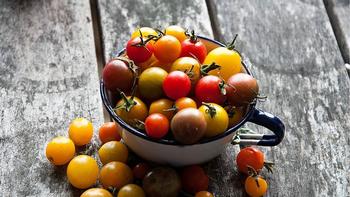Tomato FAQs
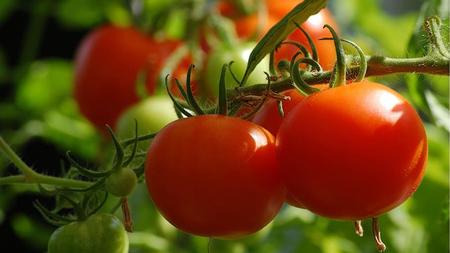
What do I need to grow tomatoes?
To grow tomatoes successfully, you should have at least 6 hours of sunlight a day, night and soil temperatures of 55 degrees, soil that is nutrient-rich and well-draining, controlled and regular watering, and strong support (cages). In areas with less sun, choose smaller size tomatoes with shorter maturing times.
What's the difference between “heirloom” and “hybrid” tomatoes?
Hybrid tomatoes are cross bred from two or more different plants and they are created for a particular purpose (disease resistance, color, shape, etc.). Their seeds will revert back to one of the parents, so they are not reliable to grow from saved seed. Heirlooms are open-pollinated and the seeds have been handed down through generation of growers, and they are at least 50 years old. They are valued for their taste, unusual markings color and shape. They can be grown from saved seed and replicate the original plant.
What is the difference between “indeterminate” and “determinate” tomatoes?
Determinate, or “bush” tomatoes grow 3 to 4 feet tall. They stop growing when fruit sets on the top bud. Fruit ripens at about the same time over a 4 to 6 week period. They need little support and are well suited for container gardening. Indeterminate tomatoes grow and produce fruit until they freeze. They can grow from 6 to 12 feet tall and they need strong support.
What does “days to maturity” mean?
It means the number of days from transplanting the seedlings into the garden until the first appearance of mature fruit.
What does “disease resistance” mean?
The ability of a plant to withstand attack from such things as fungi, viruses, and bacteria is its level of disease resistance. The common disease resistance in Marin County is from verticillium wilt (V), fusarium wilt (F), and nematodes (N).
Growing in hot climate?
Hot weather can delay a tomato crop. When days hit 85°F to 90°F and nights hover above 75°F, tomato flowers often fail to pollinate and then drop. This puts new fruit production on hold. The longer the heat lasts, the longer those tomato flowers will continue to pause. To avoid this, plant heat-tolerant varieties such as 'Heatmaster,' 'Solar Fire,' 'Summer Set,' and 'Phoenix.' It also helps to plant determinate types, whose fruit tends to ripen within a short period of time earlier in the growing season – before heat waves typically arrive.
Growing in a cool climate?
Choose varieties with fewer days to maturity. These include 'Early Girl' (59 days to maturity), 'Jetsetter' (65), 'SunGold' (65), 'Super Sweet 100' (65), 'Blush Cherry' (70), 'Chocolate Cherry' (70), Carmello (75), and 'Jaune Flamme' (75). You can increase the heat your plants receive by planting against a wall or fence that gets a lot of sun. The radiant heat will help your tomato plants. Consider tenting your plants with clear plastic sheeting to create a “greenhouse effect.”
Growing in containers?
Choose containers that are minimum 5 gallons in size (10 gallons for indeterminate varieties is better) and follow general guidelines for growing edibles in containers. Most determinate and cherry tomatoes do well in containers. Tomatoes specially developed for containers include 'Patio,' 'Pixie,' 'Tiny Tim,' 'Saladette,' 'Toy Boy,' 'Spring Giant,' 'Tumbling Tom,' and 'Small Fry.' Other recommended varieties for containers include 'Early Girl,' 'Juliet,' 'Jetsetter,' 'Sun Gold,' 'Super Sweet 100,' 'Blush Cherry,' 'Chocolate Cherry,' 'Carmello,' 'Jaune Flamme,' and 'Cherokee Purple.'
How to prepare soil?
Use our guidelines for building healthy soil.
Seeds or starts?
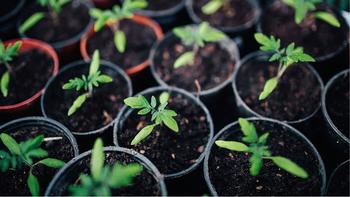
Where and when to plant?
Plant 3 to 4 weeks after the frost-free date in your area and when the nighttime temperature and soil are about 55 degrees (usually around May 1). Choose the sunniest spot -- tomatoes need a minimum of 6 hours of sun each day. Provide rich, well-draining soil. Place plants about 3 feet apart.
Avoid areas infested with weeds, where there were previous plant disease problems, or where the plants will be watered by lawn sprinklers (wet tomato foliage is susceptible to certain disorders). To reduce the risk of soil-borne pathogens, avoid planting tomatoes or members of the nightshade family (Solanaceae) in the same location more than two years in a row.
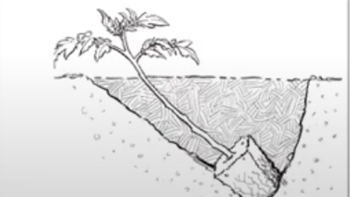 Plant tall tomato plants horizontally into the soil with just a few leaves above ground.
How to plant?
Plant tall tomato plants horizontally into the soil with just a few leaves above ground.
How to plant?

Dig a hole to accommodate the plant up to the top 2 to 3 inches of foliage (new growth will form on buried stems). Remove any flowers or buds. Add compost and fertilizer (pellet form of a balanced fertilizer) to the hole. Place plant in the hole, replace the soil and water well at the base of the plant. Stake your tomato at the time of planting. Don't forget to add a layer of mulch.
Continuing care?
You may choose to feed again at the time of fruit set. Use a fertilizer higher in phosphorus rather than nitrogen. Too much nitrogen will give you lovely foliage, but less fruit. Alternatively, you can side dress with a couple inches of compost scratched into the surface of the soil and then watered. Cut watering back to once a week (about 1 inch of water) as plants mature. Potted plants will need more frequent watering. Do not overwater or over-fertilize, and keep the foliage dry to prevent disease.
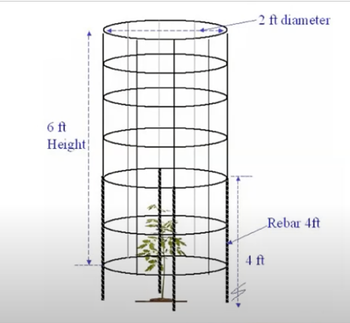 What kind of tomato cage?
What kind of tomato cage?

Look for collapsible, heavy-duty cages you can use year after year. Tomato vines are heavy and the stalks must be tied to the cage.
How much to water?
This depends on your soil and how hot, dry, and windy your site is. As a general rule, water 3 times per week to get tomato plants established. Once you see flowers start to appear, reduce water once or twice a week. Once there's fruit on the vine, reduce water to once per week. If the plant is wilted in the morning, it probably needs more water. If your tomatoes are splitting, you might be watering too much.
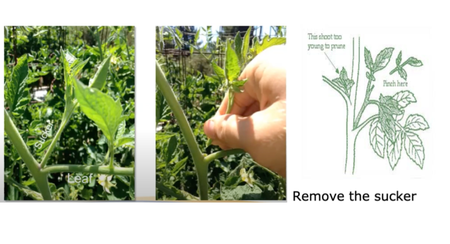 Is pruning necessary?
Is pruning necessary?

Choose the stems you want to keep and pinch out the others as they develop. Tomatoes pruned to one leader will bear earlier but with less yield overall. Plants with two or more stems produce more tomatoes with better foliage protection from the sun than plants with one stem. A dense leaf canopy may reduce the incidence of black mold and cracking but may increase the incidence of other fruit molds such as gray mold. Before removing suckers or side shoots, wait until two leaves develop and pinch above them. Indeterminate plants can grow quite tall, so you may want to cut them back to avoid out-of-reach tomatoes.
Pollination?
Tomatoes are self-pollinating, which means they contain both male and female parts. The flowers must be vibrated at a specific frequency by wind or bees in order to release the pollen for fertilization. Honeybees are unable to provide the correct vibration to the tomato flowers, but bumble bees and other native species can.
When to harvest?
Harvest when the fruit is well colored and soft but not mushy. As tomatoes begin to color, they can be picked to finish ripening indoors. Tomatoes will be ready to harvest about 6 weeks after they start to blossom or, depending on the variety, 60 to 85 days from when you planted the starts. Cherry tomatoes crack if left on the vine too long (or are over-watered). Pick them just before they look perfectly ripe.
How to store?
